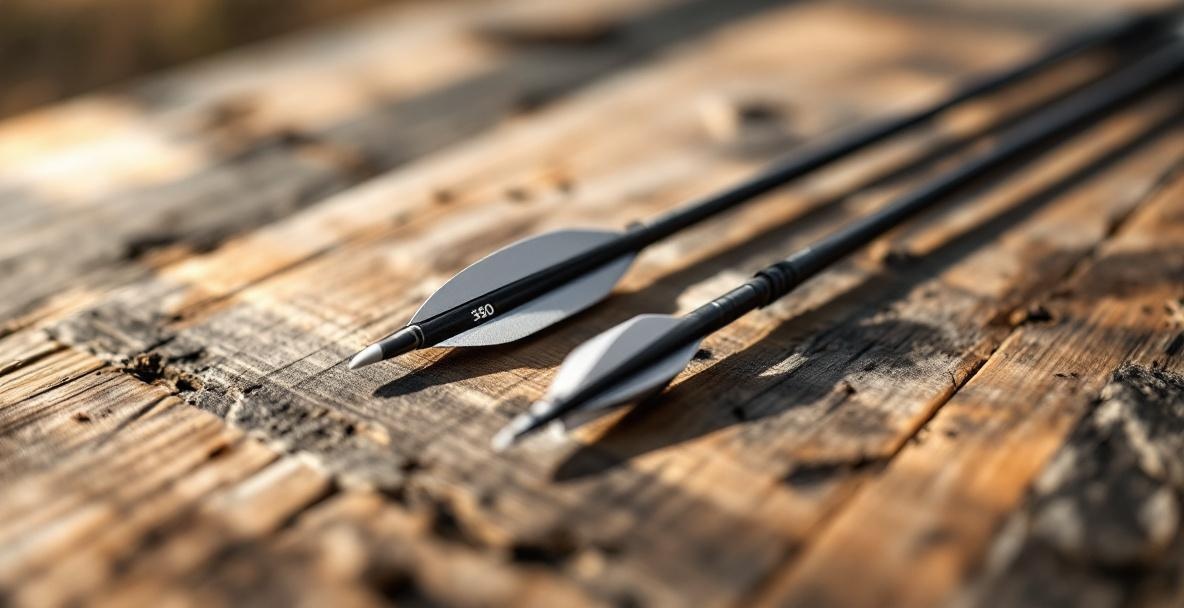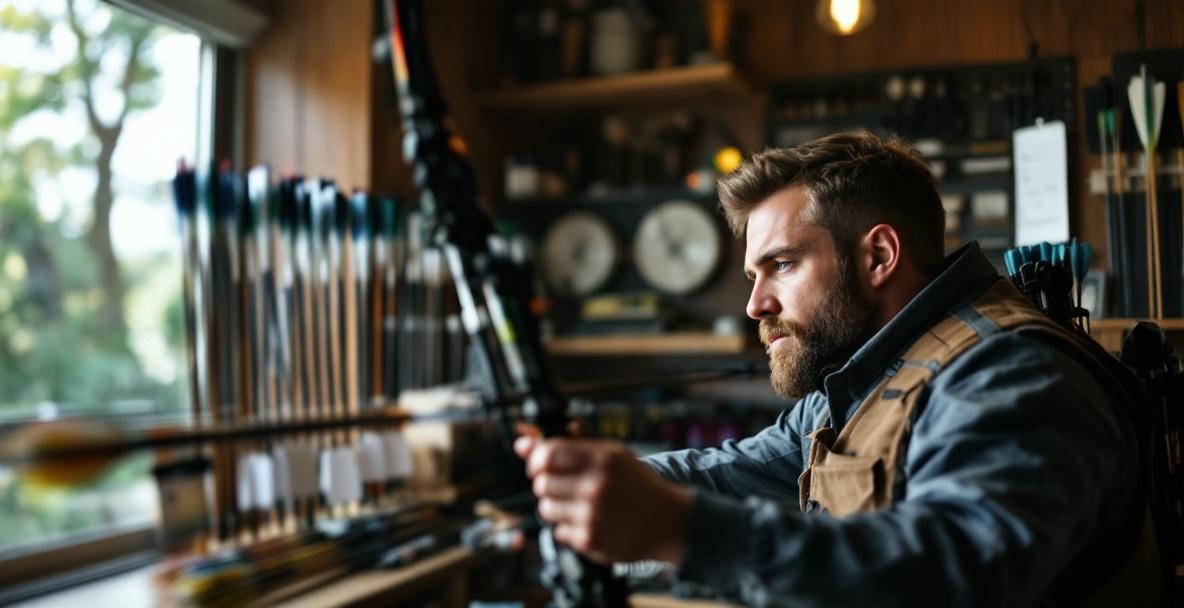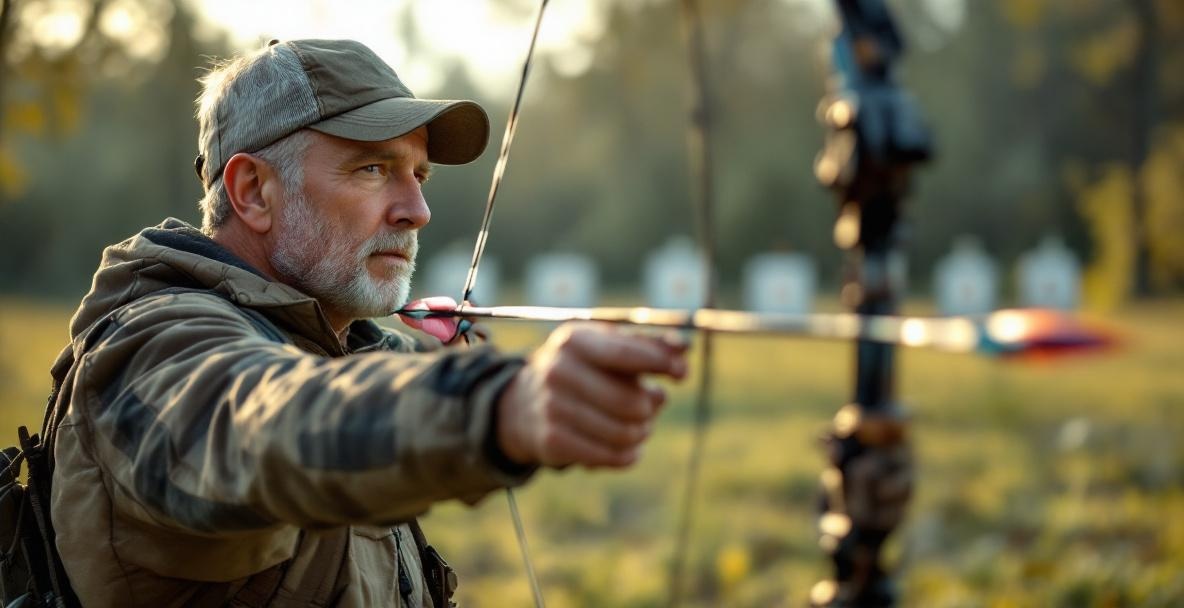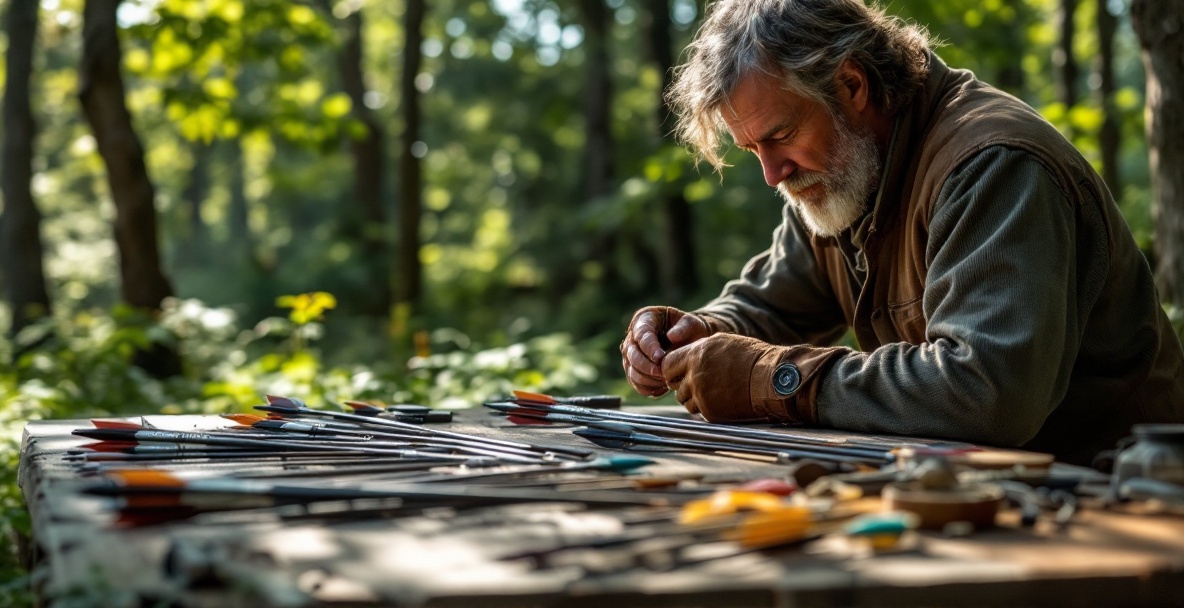Getting to Know Arrow Spine: Why It Matters

When you line up your shot, the unsung hero behind its success is the arrow spine. At OneX Archery, we know that the right spine can mean the difference between a shot that hits true and one that spins off course. Whether you’re tweaking your competition gear or just chasing down consistent hits on the range, understanding how your arrow bends is key. In every release from your fingers to the target, this detail plays a huge role.
So, What Is Arrow Spine?
Arrow spine measures how stiff or flexible your arrow shaft is, which tells you how much it bends when force is applied. When you let an arrow fly, physics takes charge right away. The force of the shot makes the arrow bend and wobble a bit around the bow in a phenomenon known as the archer's paradox. This bending is not a flaw at all but a natural part of shooting that you can improve by picking the right spine.
Arrow spine is the measure of how much your arrow bends when force is applied.
You’ll see spine ratings on arrow shafts and packaging as numbers like 340, 400, or 500. Lower numbers mean the arrow is stiffer, while higher numbers indicate it is more flexible. These ratings come from a test where a weight is placed on an arrow supported at two points, and the amount of bend is measured. Grasping these numbers is the first step to choosing gear that suits your shooting style.
Check out the quick chart below that compares common static spine numbers with how stiff they are. This reference helps you picture how these ratings work in practice.
| AMO Spine Number | Relative Stiffness | Typical Use Cases |
|---|---|---|
| 250 | Very Stiff | High-poundage compound bows (70 lb+) |
| 300 | Stiff | Powerful hunting setups (60-70 lb) |
| 340 | Moderately Stiff | Versatile target/hunting hybrids (55-65 lb) |
| 400 | Moderate | Mid-range target or light hunting bows (45-55 lb) |
| 500 | Flexible | Lower draw weights, beginner and recurve setups (35-45 lb) |
Keep in mind that the arrow’s material also plays a role. Carbon arrows, aluminum arrows, and wooden arrows each bend differently, even under the same conditions. That’s why picking the right spine isn’t just about the number on the package; it depends on your arrow’s construction too. This mix of material properties and spine rating creates a unique performance that seasoned archers know how to harness.
Why Picking the Right Arrow Spine Matters
Your shot’s accuracy is key, and that is why the arrow spine matters so much. If your arrow isn’t spined correctly, it can fly unpredictably and scatter your group, making every shot a challenge. When the arrow’s spine matches your bow’s draw weight, draw length, and shooting style, it flexes and then recovers in a smooth, predictable way, helping your arrow fly straight and hit the mark.
Accuracy is the top reason to care about arrow spine.
Safety is another big reason to get your setup right. Arrows that are too flexible for your bow can break on release, and those that are too stiff might not bend enough, potentially causing erratic flight or stressing your gear. Learning and following these safety tips helps you choose a spine that keeps you safe during practice sessions or competitions.
Using arrows with the right spine elevates your whole shooting experience. The proper spine helps reduce hand shock and vibration, making each shot feel more comfortable. This comfort boosts your form and consistency especially during long practice sessions. When paired with quality stabilizer weights, a correctly spined arrow creates a reliable shooting system that feels natural and works just right.
What Affects Your Arrow Spine Choice

Finding the perfect arrow spine is not a cookie-cutter process. There are many factors that come into play when deciding which spine rating will work best with your gear and your way of shooting. At OneX Archery, we’ve seen that paying attention to these details can boost both your accuracy and consistency. Let’s take a closer look at the main things you should consider when choosing your arrow spine.
How Your Bow's Power Affects Arrow Spine
Your bow’s draw weight is one of the biggest factors in picking the right arrow spine. In other words, a more powerful bow means you need a stiffer arrow that can handle the extra force without bending too much. For example, a bow that draws 70 pounds needs a much stiffer arrow compared to one that draws only 40 pounds.
Your bow's draw weight is a major factor in picking the right arrow spine.
If your arrow is too soft for your bow, it will bend excessively upon release, causing wild flight and poor aim. Conversely, if the spine is too stiff, the arrow won’t bend enough to smoothly navigate past the bow’s riser, leading to inconsistent flight. Many archers have struggled with accuracy issues simply because their arrow spine did not match their bow’s power.
Manufacturers usually provide charts that match draw weight to spine rating. These guides are a great starting point, though they assume typical conditions. If you’re using a compound bow with aggressive cams, you might have to choose an arrow with a slightly stiffer spine to handle the extra force. Refer to the table below as a basic reference for linking your bow’s draw weight to a recommended static spine range before you fine-tune through testing.
| Draw Weight (lb) | Suggested Static Spine | Notes |
|---|---|---|
| 30-40 | 600-500 | Youth & light recurve setups |
| 40-50 | 500-400 | Entry-level hunting, target practice |
| 50-60 | 400-350 | Mid-range compound & recurve bows |
| 60-70 | 350-300 | Powerful hunting rigs with heavier arrows |
| 70-80 | 300-250 | High-energy setups, long-range stability |
How Arrow Length Plays a Part
Arrow length makes a big difference in how the spine behaves. A longer arrow naturally bends more than a shorter one, and for each extra inch added, the effective stiffness drops by about 5-10 pounds. This is why properly measuring your arrows is so important when selecting the right spine.
To get an accurate measure, shoot your bow with good form and ask a friend to mark the arrow where it reaches the front of the riser. That mark shows your true draw length. Keep in mind that trimming an arrow will make it stiffer, while leaving it longer means it will act as if it has a softer spine.
At OneX Archery, we often chat about how arrow length influences the overall balance and feel of your gear. The interplay between arrow length and weight distribution affects not only the spine but also how your bow feels when fully drawn. Finding the right balance here helps make your shooting more comfortable and improves your consistency shot after shot.
Factoring in Your Own Style
Even though the numbers give you a good base, your personal shooting style is a big factor in fine-tuning your arrow spine choice. Some archers favor a bit more flex in their arrows because that extra bend suits their technique or smooths out minor form mistakes.
Whether your release is smooth and controlled or quick and forceful, your style can change how an arrow’s spine works for you. Many competitive archers try different spines-sometimes a tad above or below what the charts recommend-until they find that perfect match. Testing and adjusting over time is the best way to discover what really works for you.
At OneX Archery, we see arrow spine as part of your overall gear package. Your stabilizer weights, rest setup, release method, and spine all need to work together. Experimenting with different combinations will help you understand how these parts interact, leading to a setup that not only performs well but also feels right.
How to Test Arrow Spine: Handy Techniques and Tips

Figuring out the perfect arrow spine goes beyond numbers and charts-you’ve got to test it out. Even the best calculations can only tell you so much, and nothing beats seeing how your arrow flies in real situations. At OneX Archery, we blend our theory with plenty of field testing to get that perfect balance between arrow and bow, just like our quality stabilizer weights enhance every shot.
Real-world testing is key to making sure your arrow spine is just right.
Ways to Test Your Arrows Out in the Field
Start by firing a few arrows at 20 yards with your bow set up correctly. Watch the flight carefully; a well-matched arrow will fly straight with just a hint of wobble. If the arrow sways too much or moves erratically, then your spine might be off. For right-hand shooters, a spine that’s too stiff might send arrows hitting a bit to the right, whereas a too-flexible spine usually makes them drift left.
Another effective method is the paper test. Set up a sheet of paper in a frame about five feet from your shooting spot and fire an arrow through it. The tear pattern in the paper speaks volumes-a clean, even tear means your arrow spine is on point, while a tear that veers left or right suggests you might need to reexamine your setup. This test works well alongside other adjustments, ensuring your overall setup supports sharp accuracy.
Grouping your arrows is also a great indicator of the right spine. Shoot several arrows from the same distance and check how they cluster. If the arrows do not group together even when your form is solid, it may signal that the spine isn’t matched to your bow. Even with perfect form, a mismatched arrow spine can limit both consistency and precision.
How a Spine Tester Can Help You
A spine tester gives you a super-accurate measure of how much an arrow bends. The tool works by suspending an arrow between two points that are 28 inches apart and adding a set weight (usually 1.94 pounds) at the center. The resulting deflection, measured in inches, tells you the actual spine rating of your arrow. You can find these testers at archery shops or online, with prices ranging from basic models at $50-100 to professional ones costing over $200.
If you’re the DIY type, you can even build your own spine tester with simple materials, but you must calibrate it carefully to ensure the readings are right. Always take several measurements and rotate the arrow each time because an arrow might bend differently in various positions. This careful approach is very much like the precision we put into designing our OneX Archery stabilizer weights.
Once you have your measurements, compare them to the manufacturer’s specifications. This step is especially important if you’re choosing arrows for competitive events or regular target practice, as it ensures your arrows have a consistent spine throughout your quiver. Keep in mind that small differences in actual spine values might occur because of manufacturing tolerances.
Pitfalls to Watch Out For
One common mistake is relying only on the charts without putting your arrows to the test. While these charts offer a solid starting point, they don’t factor in your personal shooting style, grip pressure, or release technique. It’s important to back up what the charts say with your own shooting tests. And remember, even a small change in your bow setup should prompt a recheck of your arrow spine to ensure everything is still in harmony.
Another pitfall is not considering arrow weight. Two arrows with the same spine rating can act very differently if one is heavier than the other. Heavier arrows often need a stiffer spine to perform correctly, and many archers overlook how the weight of the point changes the arrow’s effective spine. For instance, adding 25 grains to your point can make an arrow behave as if it had a weaker spine when shot.
Temperature changes can also throw your arrow performance off track. Carbon arrows tend to stiffen in cold weather and soften when it’s hot, so if you’re shooting in different conditions, you might need to adjust your spine choice for summer versus winter. Considering how the weather affects your gear is crucial for reliable performance.
Planning ahead for weather changes ensures your arrows stay forgiving and accurate no matter the forecast.
| Weather Condition | Effect on Arrow Spine | Suggested Adjustment |
|---|---|---|
| Sub-freezing temperatures | Carbon stiffens | Weaken spine 1 – 2 classes or increase point weight |
| Extreme heat (90 °F / 32 °C +) | Carbon softens | Choose slightly stiffer arrows |
| High winds (15 mph +) | Amplifies arrow drift | Opt for stiffer, heavier shafts |
| High humidity / rain | Increases wooden arrow weight | Seal shafts; consider carbon/aluminum alternatives |
Tweaking Arrow Spine for Your Archery Style and the Weather

Nailing the right arrow spine is not a one-size-fits-all deal. It changes based on your archery style and the shooting conditions. At OneX Archery, we’ve seen archers struggle when they don’t adjust their arrow spine for their particular style or the environment they shoot in. In this section, we explore how different archery pursuits demand tailored spine choices and how weather can influence your setup.
Hunting Compared to Target Shooting
Hunting and target shooting are quite different when it comes to choosing your arrow spine. For hunting, you generally need arrows that are a bit stiffer than what the charts suggest. This extra stiffness helps accommodate heavier broadheads and ensures the arrow can punch through game while keeping a steady flight even with extra resistance.
On the other hand, target shooting works best with arrows that follow the chart exactly, since a controlled environment calls for very predictable flight. Here, getting the weight distribution between the arrow and the point right is key to scoring well. Many competitive target archers opt for carbon arrows with spine ratings that perfectly pair with their stabilizer weights, reducing bow torque at release and keeping shots true.
For 3D archery-a mix of hunting and target shooting-you need an approach that borrows from both worlds. Many 3D archers use mid-weight arrows that are a little stiffer than what the charts recommend for targets yet not as rigid as full-on hunting arrows. This balanced choice helps you handle varying distances and conditions without losing accuracy.
Handling Weather Changes with Your Arrow Spine
Weather plays a big role in arrow performance, so sometimes you need to adjust your spine for consistency. Temperature is one of the biggest factors-carbon arrows usually get stiffer when it’s cold and more flexible when it’s warm. If you shoot throughout the year in different climates, consider having a couple of arrow sets with spine ratings that match the season.
Wind can also upset your arrow’s flight. In breezy conditions, a slightly stiffer spine can help keep your arrow on track, especially if you use lighter arrows that are prone to drifting. Just remember, stiffer arrows give you less margin for error in your form. Many experienced archers cope with windy days by adjusting their aim instead of entirely changing their arrow specs.
Humidity can change arrow behavior as well, particularly with wooden arrows that soak up moisture and become heavier and more flexible. Even though carbon and aluminum arrows handle humidity better, extreme conditions can still affect performance. In highly humid settings or during rain, try to arrive early to let your equipment adjust and make small tuning tweaks as needed. Adding stabilizer weights that bring balance to your setup can help reduce crosswind effects when your bow is at full draw.
Planning ahead for weather changes ensures your arrows stay forgiving and accurate no matter the forecast.
| Weather Condition | Effect on Arrow Spine | Suggested Adjustment |
|---|---|---|
| Sub-freezing temperatures | Carbon stiffens | Weaken spine 1 – 2 classes or increase point weight |
| Extreme heat (90 °F / 32 °C +) | Carbon softens | Choose slightly stiffer arrows |
| High winds (15 mph +) | Amplifies arrow drift | Opt for stiffer, heavier shafts |
| High humidity / rain | Increases wooden arrow weight | Seal shafts; consider carbon/aluminum alternatives |
Wrapping It All Up
Choosing the right arrow spine is a key part of making every shot count. In this guide, we dug into how your gear and arrow spine work hand in hand. By understanding these details and applying what fits your style, you can set up your arrows to fly true, boosting both your consistency and the enjoyment of your shooting sessions.
What You Should Remember
Choosing the right arrow spine isn’t just another tech spec-it’s a vital part of archery success. The perfect spine is that magic spot where your arrow bends at the right moment, snaps back quickly, and heads straight to your target. Your bow’s draw weight, draw length, and the arrow’s build all come together to deliver performance you can count on.
When picking your arrow spine, look at your entire setup. Your bow’s power, the length you need, the weight at the point, and even your own shooting style all influence the ideal spine. What works perfectly for one archer may not be the best match for your unique gear and technique.
Practical testing is the best way to nail down your perfect arrow spine. Whether it’s through paper tuning, bare shaft testing, or consistent practice, you will begin to feel the impact of the spine on your shot. This hands-on experience, along with the tips we shared, will guide you in making smart choices that boost your archery skills and improve your accuracy on the range.
Moving Forward With Confidence
Getting comfortable with your arrow spine choice is part of a longer journey, not a one-time fix. Start with a small batch of arrows in your chosen spine range before committing to a full set. This approach lets you test, tweak, and learn without breaking the bank, all while you fine-tune your gear and shooting form.
Always ask for advice from seasoned archers or watch a pro in your local shop; their keen eyes might spot flight issues that you miss. The archery community is warm and ready to help, and this collaborative spirit can fast-track your progress as you find the perfect equipment for your needs.
Remember that perfecting your equipment is just one piece of the archery puzzle. Once you have your arrow spine dialed in, you can focus more on your technique, form, and mental game-the parts that really help take your archery to new heights. The right arrow spine, paired with well-chosen stabilizer weights and gear, builds a strong foundation for every shot.
Ready to take your archery performance to the next level? Visit OneX Archery today to explore our precision-engineered stabilizer weights that complement your carefully selected arrows. Our stackable system allows you to fine-tune your bow's balance for maximum stability and accuracy, helping you make the most of your perfect arrow spine setup.
Leave a Reply